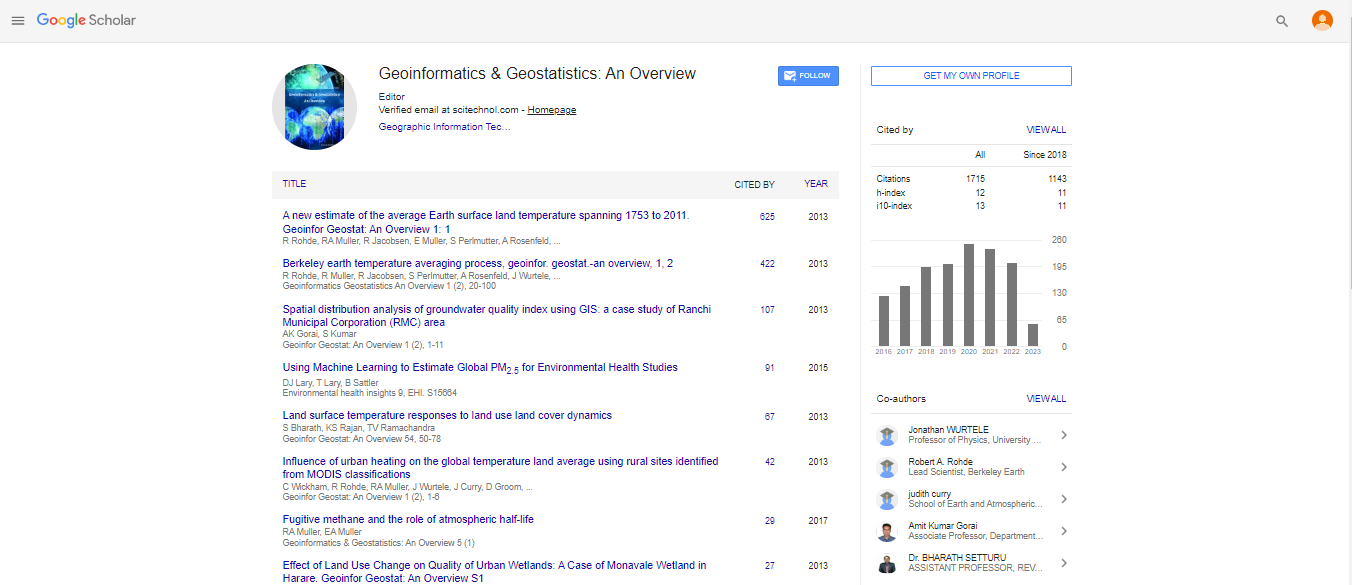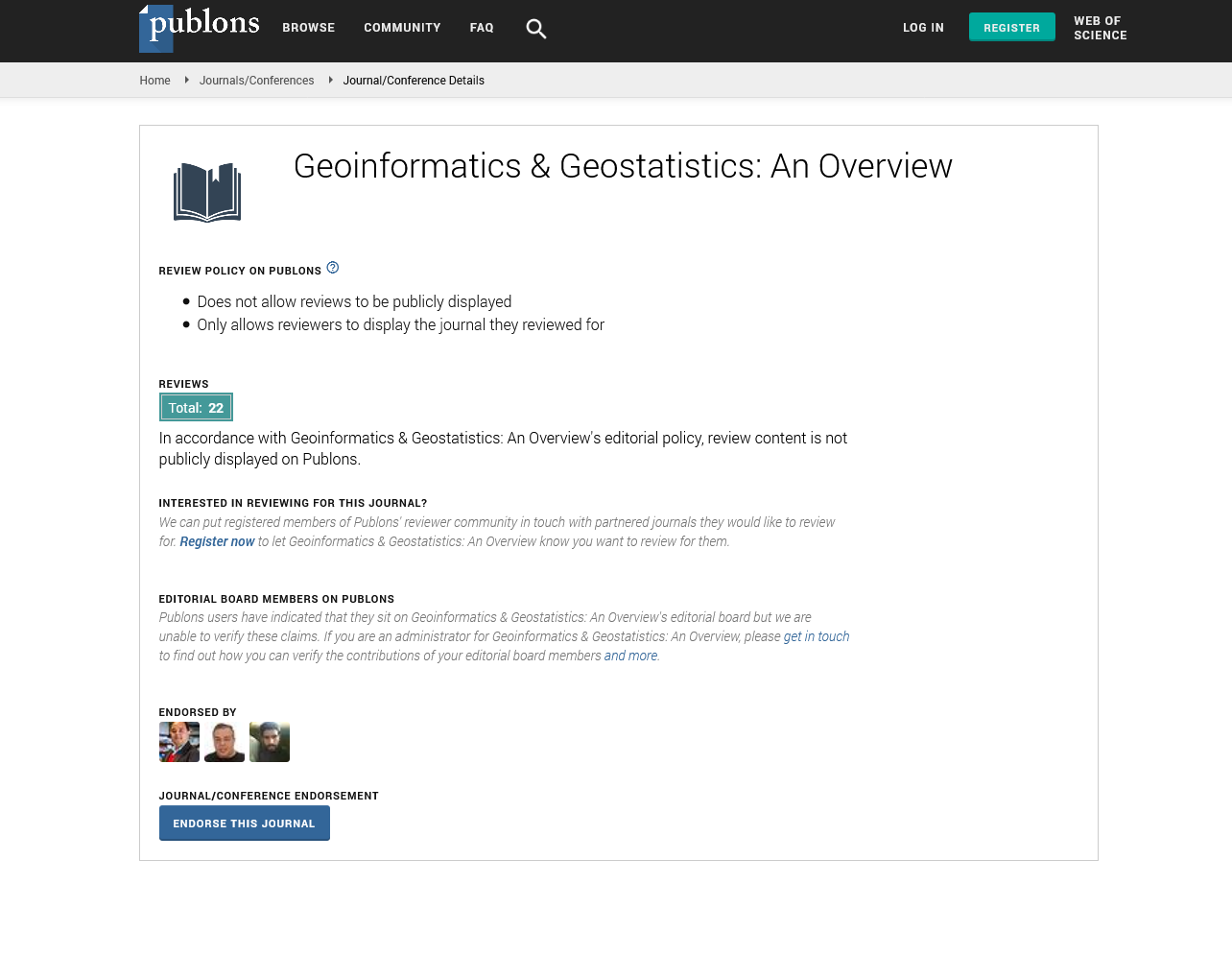Perspective, Geoinfor Geostat An Overview Vol: 13 Issue: 1
Scalable GeoAI Framework for Real-Time Spatiotemporal Event Detection in Urban Environments
John Peroche*
Department of Information Technology, Uppsala University, Uppsala, Sweden
*Corresponding Author: John Peroche
Department of Information Technology, Uppsala University, Uppsala, Sweden; E-mail: Johnpe785@hi.gs.se
Received date: 30 December, 2024, Manuscript No. GIGS-25-164062;
Editor assigned date: 02 January, 2025, PreQC No. GIGS-25-164062(PQ);
Reviewed date: 16 January, 2025, QC No. GIGS-25-164062;
Revised date: 23 January, 2025, Manuscript No. GIGS-25-164062(R);
Published date: 30 January, 2025, DOI:10.4172/2327-4581.1000429.
Citation: Peroche J (2025) Scalable GeoAI Framework for Real-Time Spatiotemporal Event Detection in Urban Environments. Geoinfor Geostat: An Overview 13:1.
Real-time detection of spatiotemporal events in urban environments is important for applications such as disaster response, traffic management and public safety. Traditional methods often struggle with the scale, velocity and heterogeneity of urban data. In this paper, we propose a scalable GeoAI framework that leverages distributed computing, deep learning and geospatial analytics to detect and monitor events in real time. The system integrates diverse data streams ranging from satellite imagery and traffic sensors to social media into a unified architecture optimized for speed, scalability and accuracy. We demonstrate the framework's effectiveness through case studies in traffic incident detection and flash flood monitoring across multiple urban centers.
Urban environments generate vast volumes of spatiotemporal data daily from heterogeneous sources, including sensor networks, social media, mobility logs and Earth observation platforms. The ability to detect significant events such as traffic disruptions, natural disasters, or public gatherings in real time is essential for smart city applications. However, existing systems often lack scalability, are limited to specific data modalities, or suffer from latency issues. This paper introduces a scalable GeoAI framework designed to overcome these challenges by combining big data processing with deep geospatial intelligence.
Prior work in spatiotemporal event detection includes rule-based systems, statistical anomaly detection and machine learning approaches. Recent advances in GeoAI have shown promise by incorporating spatial deep learning into geospatial pipelines. However, many solutions are limited in scalability or depend heavily on static datasets. Our framework builds on these foundations but introduces a unified, distributed architecture capable of ingesting high-velocity urban data streams in real time.
A Scalable GeoAI Framework is an advanced computational architecture designed to efficiently handle and analyze massive volumes of geospatial data using artificial intelligence and machine learning techniques. As the volume, velocity and variety of geospatial data continue to grow driven by satellites, sensors and social media there is a pressing need for frameworks that can scale horizontally across distributed systems while maintaining high performance. This framework integrates key components such as automated data ingestion from diverse sources, preprocessing pipelines for georeferencing and noise reduction and distributed storage and compute layers powered by platforms like Apache Spark, Hadoop, or cloud-native services.
At its core, the framework embeds AI and deep learning models such as convolutional neural networks for image classification or transformers for spatiotemporal forecasting to extract meaningful patterns and predictions from complex datasets. A robust analytics engine enables multidimensional analysis across space and time, supporting applications like urban growth monitoring, disaster prediction and precision agriculture. Furthermore, the framework ensures interoperability through adherence to open geospatial standards and provides real-time visualization and decision support through web-based dashboards and GIS integrations. Altogether, a scalable GeoAI framework empowers researchers, planners and decision-makers to transform raw geospatial data into actionable intelligence at unprecedented speed and scale.
Conclusion
In Houston, Texas, we integrated radar rainfall data, social media mentions of flooding and ground sensor data. Our spatiotemporal fusion engine detected flood events with a lead time of 10-15 minutes ahead of official alerts, showing strong potential for early warning systems. The system was deployed on a Kubernetes cluster across 10 nodes using GPU-enabled containers. It processed up to 200,000 spatiotemporal records per second with sub-second inference latency. Benchmarks indicate near-linear scalability when increasing compute resources. We presented a scalable GeoAI framework capable of real-time spatiotemporal event detection in urban environments. Its modular design supports diverse data types and can adapt to various urban scenarios. Future work includes integrating edge AI for low-latency inference and expanding to global urban regions for cross-city learning.
 Spanish
Spanish  Chinese
Chinese  Russian
Russian  German
German  French
French  Japanese
Japanese  Portuguese
Portuguese  Hindi
Hindi 
